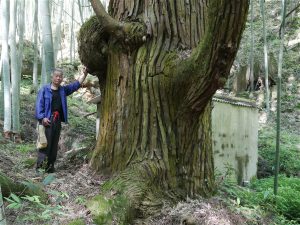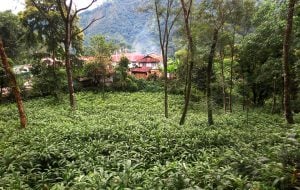Large-scale tree planting efforts in India, China and South Korea have removed more than 12 billion metric tonnes of carbon dioxide from the atmosphere over the past 20 years, according to a new analysis.
Examining different afforestation, reforestation, and forest restoration (ARR) programmes in the three countries, a report by Michael Wolosin, president of Forest Climate Analytics, shows how efforts to restore and expand forests have already provided significant carbon removal benefits.
The analysis also shows how countries can protect, expand and improve the management of forested lands, which act as crucial “carbon sinks” to keep emissions out of the atmosphere – a key component to meeting the Paris Agreement’s goal of limiting global warming to 2 degrees Celsius.
By stopping deforestation and allowing young secondary forests to grow back, the world’s cumulative “forest sink” could grow by more than 100 billion metric tonnes of carbon by 2100, according to a summary of the latest research on forests and climate change by the Woods Hole Research Center. This is about ten times the current rate of annual global fossil fuel emissions.
Unique approaches
India, China and South Korea have each approached ARR differently, and for various reasons, with their governments either spearheading the programmes or merely acquiescing to them.
In both South Korea and China, environmental crises forced the countries to take action. For South Korea, the main issue was soil erosion, which moved from being an environmental issue to a political one following a flood that killed more than 300 people in the 1970s.
But ARR efforts, championed by President Park Chung-hee, were already well underway in South Korea by this time. In 1967, the bureau in charge of forests was removed from the Ministry of Agriculture and Forestry and given its own ministry. Local communities were also deeply integrated into the forestry programme and village communities had to volunteer for the project – and only they were allowed to use firewood from the commons. South Korea’s rapid urbanisation also lessened human pressure on forests. Although forest cover declined a little overall its density increased tremendously.
In China, deforestation was largely driven by the timber industry and although commercial forests were planted, extraction far exceeded supply. By the late 1970s, deforestation had caused the Gobi Desert to encroach on China’s rich agricultural lands, threatening its food security.
In response, the government launched the largest forestation programme ever envisioned; the Three-North Shelter Forest Program (TNSFP) set out to plant 100 billion trees over 73 years, which would establish 35 million hectares of protective forest across northern China. In an area accounting for 42% of China’s land mass, the plan aimed to increase forest cover from 5% to 15%.
But timber extraction continued and China’s environment degraded further. In May 1993, a cataclysmic sandstorm, dubbed the “black wind”, killed hundreds of people and destroyed hundreds of thousands of hectares of cropland. And in 1998, a devastating flood killed hundreds and left 15 million people homeless.
The state responded by allocating 725 billion yuan (US$113 billion) into 20 new programmes aimed at afforesting about 55.6 million hectares. “In other words, China intended to afforest nearly half of its available land in just one decade,” says Wolosin in the report.
The largest was the Grain for Green Project (GGP) which paid landholders with grain and/or cash subsidies for re-establishing grasslands and forests on degraded or steeply-sloped farmland, or on barren lands.
These initiatives did have an impact but afforestation may not have been as successful as the government has claimed; the survival rate of trees in China’s 1952-2005 afforestation projects was 24%, while just 15% of trees survived over the same period in the drier regions of the TNSFP, according to Wolosin’s analysis.
India’s bottom-up model
India’s story is radically different from that of South Korea or China. It has not faced the same crises, rather the issue of dealing with the environment and forestry has been a constant and increasing concern, pushed by civil society.
India has provided consistent budgetary support for forestry efforts. From 1952 to 1980, about 0.39% of the total central planning outlays were allocated to afforestation, increasing to more than 1% from 1985 to 1997. Nevertheless, the recent granting of rights to forest communities and their involvement in forest management may prove even more significant.
Because India’s focus on these issues has been led from the bottom-up, the data are the least reliable of the three countries analysed. No ministry exclusively deals with forestry and India has invested the least per hectare in its afforestation initiatives. However, if these are linked more effectively to local communities than in other countries, they may be more successful and sustainable.
This was emphasised by Bhaskar Singh Karky, resource economist at the International Centre for Integrated Mountain Development, at a side event at the recent climate talks in Bonn. Speaking about the challenges Nepal faces due to glacier retreat, air pollution and climate change impacts, Karky said that planting more trees and saving forests are among the most important solutions.
“This is ecosystem-based adaptation. This is community based. It promotes a green economy through biodiversity conservation. It is also in line with the Paris Agreement and the sustainable development goals,” he said.
He added: “The forestry sector offers solutions to the climate problem but we have to push it through a combination of carrot and sermon rather than carrot and stick.
“We have to convince the farmers on the one side, and global policymakers on the other.”
China’s high investment model and South Korea’s urbanisation and forest cover programmes hold important lessons. But India’s low-cost model may be the most easily replicable for poorer countries.
While India’s afforestation efforts have led to the least carbon sequestration among the three, it may also be the most economical way of removing carbon from the atmosphere.
This article was first published on The Third Pole









